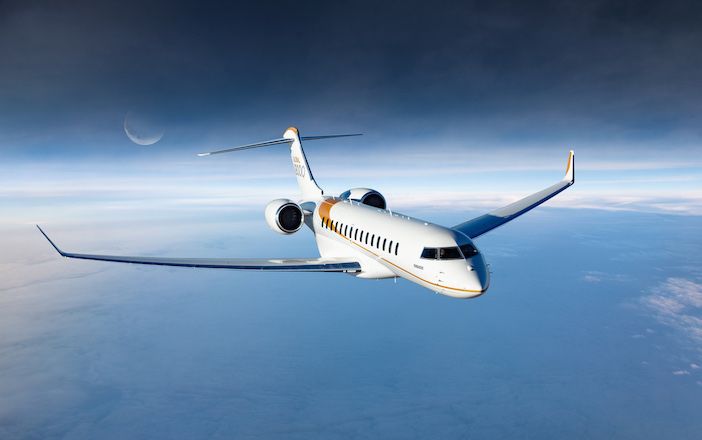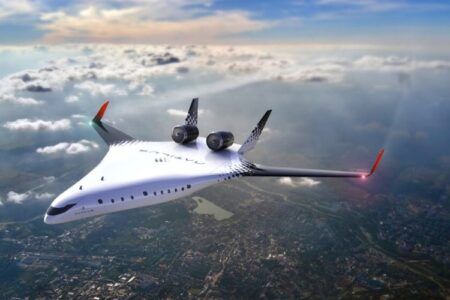by Paul E Eden
Bombardier invited guests to its European Business Aviation Convention and Exhibition booth for a special event on 23 May 2022. A stage and big screen promised a major announcement, while there were celebratory drinks and a singer even before the countdown to revelation began.
The movie that followed was silent thanks to an audio-visual gremlin, but Bombardier chose to try again. With sound, its announcement rang out loud. Not only had the Global 8000 arrived but, represented by the modified fifth Global 7500 flight test vehicle (FTV5), it had exceeded Mach 1. It was the fastest commercial aircraft since Concorde.
At no point did the OEM suggest its aircraft was supersonic, merely that its performance was sufficiently high for testing to take it beyond Mach 1. Many guests inevitably came away discussing Bombardier’s ‘supersonic bizjet’, perhaps not fully appreciating that the company has created a machine of stunning performance. Capable of reaching Mach 0.94, it will also fly 9,200 miles (14,800km) at Mach 0.85. Surprisingly, there is no external difference between the Global 7500 and 8000. Remarkably, Bombardier is offering the Global 8000 as a new build jet, or by retrofit from the earlier model.
Service entry is expected in 2025 as trials continue beyond the envelope expansion work that saw the sustainable aviation-fuelled FTV5, an aircraft known internally as the “Masterpiece” and originally employed as the Global 7500 entry into service validation aircraft, repeatedly achieve Mach 1.015 in May 2021. Bombardier’s Stephen McCullough, vice president of engineering, provided a program update during the National Business Aviation Association Business Aviation Convention and Exhibition in Orlando during October 2022.
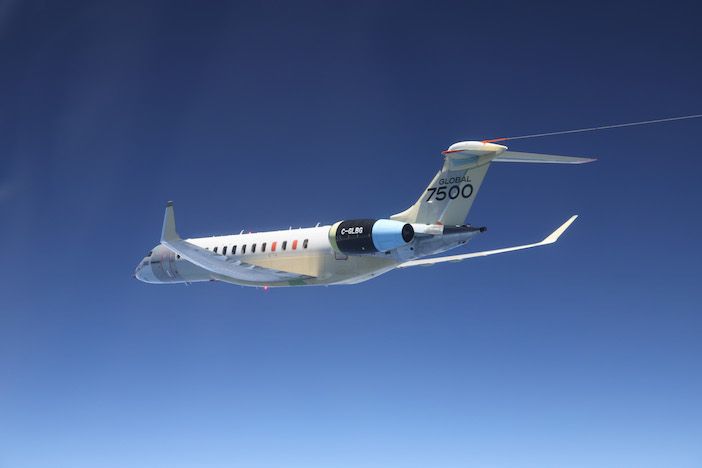
No compromise
Describing the Global 8000’s evolution from the 7500, McCullough says, “We spent a lot of time designing the 7500. I’m something of a perfectionist and if you look at the wing it shows our no-compromise approach – we did lots of work in the wind tunnel, optimizing the wing for high and low speeds. The Global 8000 taps the extra potential available from that approach.”
Software changes, in “multiple areas”, according to McCullough, drive the process of unlocking Global 8000 performance from the 7500 design. “The physical shape and context of the aircraft was there, with no requirement for change,” McCullough says. “It is by design philosophy, it’s not by accident that the capability was there. There are features on the 7500 wing, the split aileron for example, that we know gives us more capability. We saw features at the extremes of the Global 7500 operating envelope that reinforced the potential for more capability and that comes from a robust design philosophy which itself comes from years of having gone through entire aircraft cycles.”
McCullough confirmed that Bombardier is examining a small cruise thrust increase for the Global 8000’s General Electric Passport engines compared to the Global 7500’s otherwise identical powerplant. The new model also has a greater usable fuel load, achieved through means other than installing larger tanks.
McCullough explains, “Modern aircraft typically have a myriad of interrelated systems, including flight management systems and when we say ‘a software change’ it’s rarely changing a single number in the code.
“Also, when you look at full fuel quantity, it isn’t just the ability to store fuel, it’s also about what you do in terms of the space above the fuel, the ullage space, so a lot of the fuel management process is about making sure the vent system, for example, works in all perceivable conditions. There’s also an element of repeatability, knowing that you can build a number of aircraft with exactly repeatable fuel capacity, but we are also applying quite a bit of science around how we manage fuel vents and fuel vent storage.”
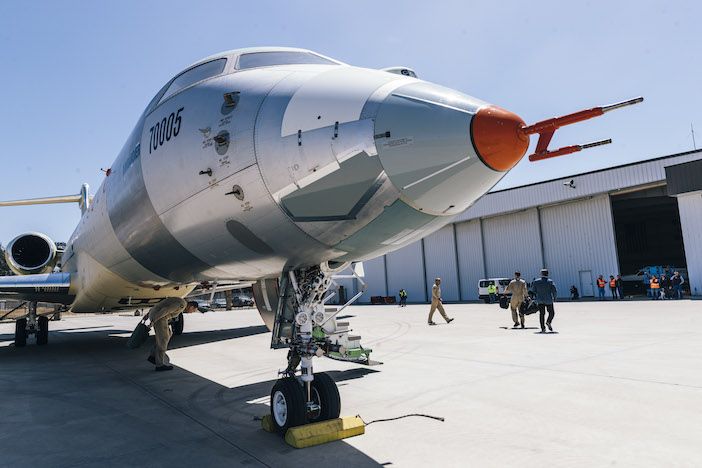
Flight validation
After each aircraft development cycle, Bombardier reviews its work and optimizes its predictive tools ready for the next cycle. “We have integrated systems test rigs, REFS [reconfigurable engineering flight simulators] and an ESIM [engineering simulator], within what we call the BES [Bombardier Engineering System]. It’s the result of 30 years’ work and means we create very robust products,” McCullough says. It also means that much of the focus of flight testing is in the regime of flight validation and that the flight test crews had completed many hours of Global 8000 flying in the virtual world long before it took to the air for the first time.
During the Global 7000 flight test program, FTV1 achieved Mach 0.995 on 29 March 2017, but Bombardier had never gone supersonic. “We hadn’t been in that regime before, so there was a need for validation,” McCullough says. “Thinking about our demonstration of compliance, we have a normal envelope and a test envelope and as an OEM it’s our responsibility to go beyond the normal envelope.” The process for clearing the Global 7000 to Mach 0.925 required it to reach Mach 0.995. Clearing the Global 8000 to Mach 0.94 therefore inevitably required the aircraft to exceed Mach 1, but McCullough says the exercise was not about making the jet go faster.
“It was really about showing that the analytics were good. An operational aircraft could be affected by wind or some other influence that takes it beyond Mach 0.94 and the best way to show robust compliance was to go beyond Mach 1. It was a very premeditated test, we signed off on the safety of flight, completed all our safety reviews and then did it.
“The entertaining part was finding a chase aircraft that could keep up and was able to provide a calibrated airspeed indication at speeds beyond Mach 1. We ended up going to NASA and using one of their F-18s.”
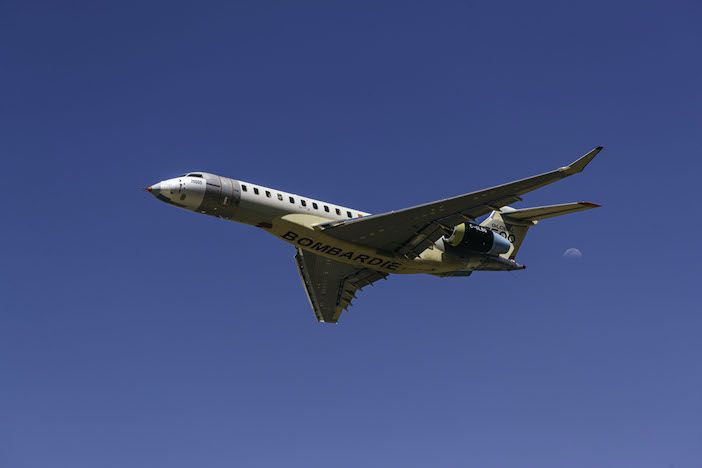
At this point Mathieu St. Cyr, manager, sales engineering, excitedly reveals, “It was so cool because the Hornet had to use afterburner to keep up with the 7500 test vehicle.”
“The test was uneventful,” McCullough continues, “But gave us lots of good data to validate our tools and demonstrate compliance at Mach 0.94.” He also admits that one of the most difficult aspects of the entire process was keeping the achievement secret – a full year elapsed between the Mach 1 campaign and Bombardier’s May 2022 Global 8000 reveal in Geneva.
And he concedes that while the test itself was “uneventful” it brought a big smile to his face. “You can’t have aviation in your blood, go beyond Mach 1 and not be happy. There are moments in your career you remember. For me this is one of those, along with flying to Farnborough in the back seat of a Shorts Tucano, and the first flights of the Challenger 605 and Global 7500.”
St. Cyr concedes that the excitement in May 2021 led to considerable discussion about whether an early announcement of the achievement should be made, or it should be kept under wraps until the full Global 8000 package had been defined. The latter won out and McCullough feels that was a wise decision.
“When we offer something, we have a high level of confidence and for the 8000 we needed to do other tests, on fuel quantity for example. We looked at Global 7500 fleet service data to ensure we had numbers, artefacts, that demonstrated what we would deliver on our commitment,” McCullough says.
Data driven
Since the trials employed the already instrumented FTV5, there was no requirement to modify an airframe with sensors or telemetry. In any case, modern business jets as exemplified by Bombardier’s Global family of aircraft, feature data collection and transmission systems. Including aircraft health monitoring, these feed into the fleet service data McCullough references, and inform airframers, engine makers, and operations departments as well other stakeholders on aircraft performance and serviceability.
So much data is gathered from regular in-service jets that McCullough says the challenge is no longer how to collect it but how to analyze it quickly. “Because we used FTV5 we didn’t need to use those regular data collection sources during the flight trails, but we did use telemetry, with either our station at Wichita or our mobile test cart. We can have a flight test engineer on board the aircraft too,” he explains.
Clear risk protocols govern trials outside the previously explored envelope, with carefully defined ‘knock it off’ points at which the flight test engineers in the telemetry stations or on the aircraft halt a test. The aircraft’s standard systems may support test points, however. “With items like fly-by-wire, we have the ability to excite surfaces using the aircraft’s native system in a flight test software mode, which is quite different to the past,” McCullough enthuses.
“Our playbook is phenomenal compared to what it used to be.”
The Global 8000 type certificate will retain the BD-700-2A12 model number of the Global 7500, with Global 8000 identified on the type certificate data sheet as a subset designation. When customers choose to modify a Global 7500 to 8000 standard, a service bulletin will apply, delivering the improved performance and verifying the upgrade. The work will be performed within Bombardier’s worldwide service network, with the precise mechanism to be defined after certification.
St. Cyr once again emphasizes that the changes are mostly software driven but also notes: “There will be changes to the pressurization system and engines, while the plan is to build a first production aircraft, deliver in 2025 and offer the retrofit very soon after.”
A Global Career
Asked to describe his role at Bombardier, McCullough says: “My current title is vice president of engineering, but that’s only one part of it. I’m also chief of aircraft design and development.
I was born in north Belfast, Northern Ireland and joined Shorts in 1989, just as the company joined the Bombardier family. Originally a powerplant engineer, I was chief engineer for aerostructures in 2000, and previously worked on the last complete aircraft program delivered from the facility, the Tucano. It was a great aircraft, simple yet complicated enough to build a basis for aviation around, and it helped me catch the aviation bug.”
McCullough subsequently moved on to Bombardier’s expanding business jet portfolio, including the Global Express and Challenger. In 2001 he took a role managing CRJ900 certification flight test in Wichita, Kansas. “Managing a flight test program was a kind of rite of passage to running an aircraft program, because it places you in the midst of the product, working with experimental test pilots. After that I was director of completions at our Tucson facility and finally found my way to Montreal in the mid-2000s, as director of challenger engineering.
“From there I ran the Challenger 605 engineering program from start to finish, and worked in other roles, culminating in chief of engineering and head of the IPDT [integrated product development team] for the Global 7000 [later redesignated Global 7500] before my current position. I love my job. It’s a passion.”
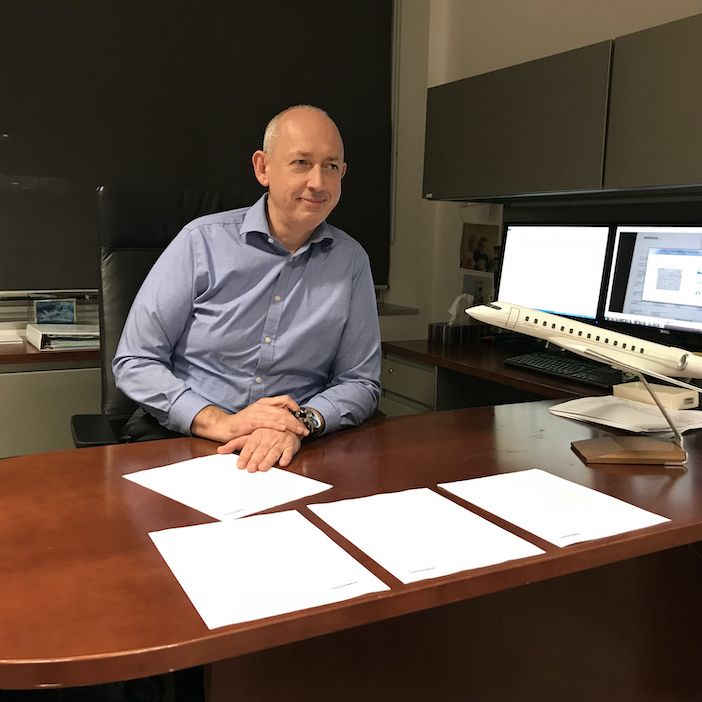
(Image: Bombardier)


